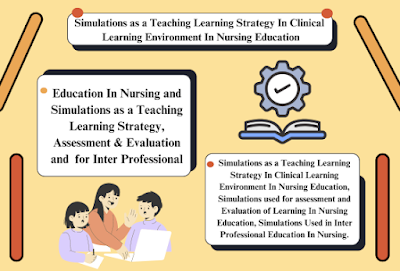The Simulations as a Teaching Learning Strategy Assessment and Evaluation and for Inter Professional In Nursing Education. Simulation is a teaching method and strategy for learning and understanding theoretical knowledge and skills in the fields of nursing and medicine.
The Simulations as a Teaching Learning Strategy Assessment and Evaluation and for Inter Professional In Nursing Education
Simulations, particularly those for inter-professional education (IPE), provide nursing students with a dynamic and safe environment to learn, practice, and develop teamwork skills. They allow students to experience real-life scenarios, hone their decision-making skills, and improve their communication with other healthcare professionals. At the same time, they minimize the risks associated with live patients.
Simulation-based teaching involves creating controlled, interactive scenarios that mimic real-life situations for students to navigate. For example, it might include a mock business scenario in an economics class. This method helps students practice decision-making and problem-solving without real-world consequences.
The Simulations as a Teaching Learning Strategy
Simulations are a powerful teaching strategy that allows learners to experience and practice skills in a safe, controlled environment, replicating real-world scenarios to enhance understanding and retention.
Assessment & Evaluation and for Inter Professional In Nursing
1. Evolution of Simulations
- Historical Context: Low-fidelity simulations, such as manikins, role plays, and case studies, have been used in nursing education for decades.
- Advancements: The introduction of high-fidelity simulations in the late 1990s, including affordable and versatile human patient simulators, has revolutionized healthcare education. These simulations now serve as foundational tools for teaching, assessment, evaluation, and clinical practice.
2. Current Application
- Teaching Strategy: High-fidelity simulations provide realistic, interactive experiences that enhance learning. They allow students to practice clinical skills and decision-making in a controlled environment, bridging gaps left by traditional clinical placements.
Simulations for Assessment and Evaluation in Nursing Education
1. Integration into Learning Processes
- Purpose Identification: Faculty must clearly define the purpose of simulations used for assessment and evaluation to ensure alignment with learning outcomes (Adamson, 2014).
- Types of Assessments:
- Formative Assessments: Used to monitor progress and guide learning within an educational activity or training.
- Summative Assessments: Employed in high-stakes situations such as graduation or certification.
2. Validity and Reliability
- Validity:
- Construct Validity: Ensures the assessment measures the intended knowledge or skill dimensions.
- Concurrent Validity: Compares simulation assessment results with traditional assessment scores (e.g., standardized patient checklists).
- Predictive Validity: Assesses whether simulation performance predicts future clinical performance, a more complex process requiring long-term tracking (Jeffries, Hovancsek, & Clochesy, 2005).
3. Types of Simulation Assessments
- Low-Stakes Assessments: Measure progress toward personal or course goals.
- High-Stakes Assessments: Include licensing, certification, and employment evaluations, utilizing various technologies such as case studies, standardized patients (OSCEs), and high-fidelity simulators.
4. Technological Advances
- Enhanced Tools: Newer tools, including sophisticated manikins and computer-based evaluation techniques, improve the assessment of learning and the preparation of students for competent patient care.
Simulations in Inter-professional Education (IPE) in Nursing
1. Definition and Importance
- IPE Definition: Involves two or more professions working together and learning from each other to improve collaborative practices and patient care quality (Newton, Bainbridge, & Ball, 2014).
2. Historical and Current Context
- Historical Background: While IPE has been documented in Canada for over 50 years, it has gained prominence in recent years, with many health education programs integrating IPE into their curricula.
3. Benefits of IPE
- Breaking Barriers: IPE helps in overcoming real and perceived barriers between different clinical disciplines.
- Enhancing Cohesiveness: Fosters a better understanding and mutual respect among team members.
- Improving Care: Knowledge of other professionals’ roles and skills is crucial for effective and safe patient care (MacDonald et al., 2010).
4. Research Findings
- Knowledge Acquisition: Studies show that immersive clinical simulations in IPE settings enhance students’ understanding of other professions and their roles.
- Value of Simulation: Realistic scenarios and well-facilitated debriefings increase the appreciation of inter-professional learning, although evidence-based strategies for implementing IPE are still developing (Alinier, Harwood, & Harwood, 2014).
5. Future Directions
- Research Needs: More research is required to quantify the effects of IPE on clinical practice and student integration into the workforce. Developing easily adoptable strategies for effective interprofessional collaborative learning remains a priority.
Read More:
https://nurseseducator.com/didactic-and-dialectic-teaching-rationale-for-team-based-learning/
https://nurseseducator.com/high-fidelity-simulation-use-in-nursing-education/
First NCLEX Exam Center In Pakistan From Lahore (Mall of Lahore) to the Global Nursing
Categories of Journals: W, X, Y and Z Category Journal In Nursing Education
AI in Healthcare Content Creation: A Double-Edged Sword and Scary
Social Links:
https://www.facebook.com/nurseseducator/
https://www.instagram.com/nurseseducator/
